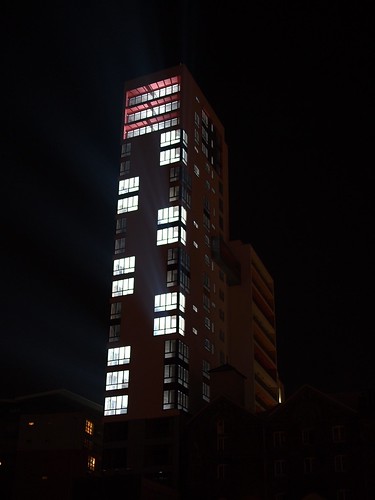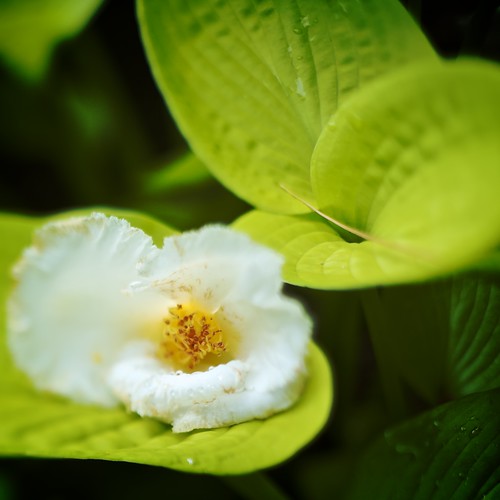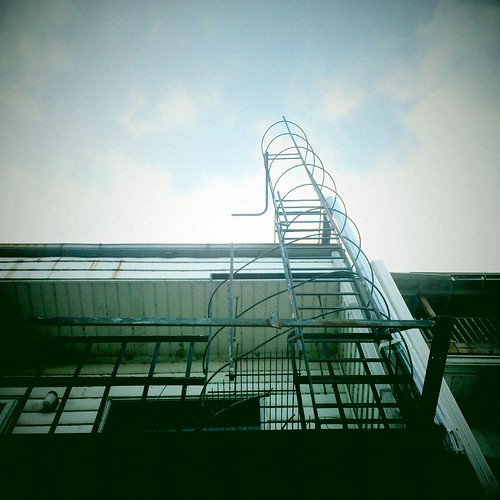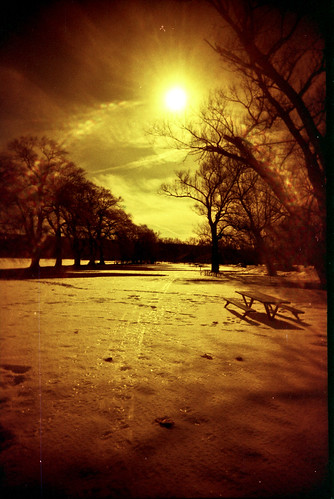skip to main |
skip to sidebar

© 2010 Simon Hucko
As you may or may not know, I am now posting a weekly theme/assignment to go along with this project. The theme is optional, but is supposed to help jumpstart your creativity and get you shooting. If you're struggling to get a photo one week, check out the assignment and take 15 minutes to grab a shot for it. I'll try to keep them pretty general and open so that you won't have to hunt too hard for a subject.
This week's theme was "doors", which is a personal favorite of mine. However, I think I'm the only one who took a door photo this week... Maybe next week's will be more popular. For my shot this week, I re-visited a photo I had taken with my phone. I like going back and improving some of my old favorites from time to time, and I couldn't resist this shot. The shadow above the door was a bit of an added bonus - I had taken the previous shot later in the day so I didn't realize it would do that. Black and white helps emphasize the shapes and textures, and also the different levels of light and shadow.
I actually have two picks this week. The first is "the longest day" by [Adam_Baker]:

© Adam Baker
I love the 3D feel of this photo, and the colors are just mind-blowing. I like the square crop, too, gives it a very balanced feeling. Finally, the composition is great, with the rock in the foreground echoing the sunburst on the horizon. And those clouds! Lots of goodness going on here.
My other pick is "The Mill, Ipswich" by q-pix:

© q-pix
I picked this one because of the cool effect with the light trails coming away from the windows. I don't think I'd always want my lens giving me flare like that, but in this case it really adds a lot to the photo. edit: I've been corrected. Apparently the light trails were visible in person. Excellent capture, then :)
Ok, that's it for this week. Next week's assignment will be "Blue." Looking forward to seeing your photos.
~S
[title of blog] on flickr
With the 4th of July coming up here in the States, I thought I'd link you to my favorite fireworks tutorial:
How to Photograph Fireworks (Digital Photography School)
Short version:
- Tripod (required)
- Remote Trigger (highly recommended)
- Manual Exposure (stop freaking out. Set it to your lowest ISO, f/8-ish and 5 seconds exposure to start. Adjust exposure time and aperture as necessary)
- Manual Focus (set it to infinity or focus on a street light far away and turn off auto-focus)
- Location/Composition (include something interesting in the foreground to give context and add interest to your shot)
Can't wait to see 'em!
~S
[title of blog] on flickr
I've been thinking about what I wrote in the wrapup this week, and decided that I'll try giving out weekly assignments. These are optional, but if you're looking for some inspiration it'll help get your creative juices flowing. I'll post the next week's assignment in my weekly wrapup, as a discussion thread in the flickr group, and as part of the group name.
You can handle these assignments in two ways. They're great for a photo walk, especially if you're walking somewhere you've been before - it gives you something to focus on rather than wandering aimlessly, and can help you see interesting images that you may not have considered before. You can also use them as a little muse in the back of your mind during the week, and whenever you see a good example of it pull out whatever camera you have with you and capture the image.
This week's assignment is one of my favorites: doors. Find an interesting door and share it with us! This is a good way to work on perspective, too - try to center your camera with the door and hold everything level and perpendicular to get nice straight lines (maybe even break out the tripod). Or don't, if that's not your thing.
Go shoot!
~S
[title of blog] on flickr

© 2010 Simon Hucko
Another low turnout this week. What can I do to help you guys get out there? Would a theme or an assignment help? Monthly? Weekly? Let me know what I can do to help inspire your photography, here in the comments or over on twitter.
My shot this week was another experiment with freelensing. I think I could have improved on it by having the entire flower in focus (instead of letting the left side go soft), using a smaller aperture or less of a tilt. I'm still feeling out this freelensing thing, and that's part of the fun - learning by trial and error. Pixels are cheap and plentiful, and it's fun to stretch my craft a bit.
This week's pick is "Flippin Burgers" by djhucko:

© Dan Hucko
I like the effect of the plastic window in front - it softens everything in the image and gives it more of an abstract feel. The focus isn't so much on the man flipping burgers, but the experience of being at a festival at night eating street food. The exposure reinforces this, holding the lights and letting the man's face stay in shadow. I like the touch of motion blur on his tongs, too, it gives it a nice dynamic feel. The only thing I might have changed would be to crop in a bit on the right to remove the edge of the window. Great street shot.
Go shoot! Do it! Seriously, just do it! No excuses!
~S
[title of blog] on flickr
Inspired by my megapixel rant, I decided to weigh in on what I thought *was* important when buying a camera. I covered DSLRs in my last post, so now I'll tackle the world of point n shoots. Here's what I think you should look for when purchasing a new point n shoot camera:
Price. Again, you probably have a budget. The nice thing about point n shoots is that there are very few accessories that you will feel a need to buy, so you can spend most of your cash on the actual camera. I do recommend some sort of small tripod (like a Gorillapod), a simple carrying case, and an extra memory card or two, but you probably won't ever need much more than that. Also, don't be afraid to buy an older model. Point n shoots get refreshed yearly (sometimes more) with minor "upgrades," so you're really not missing that much if you go back a generation or two.
Purpose. How do you see yourself using this camera? Will it be your only camera? Or is it a smaller backup/carry around camera to go with your DSLR? Perhaps you want something more rugged and splash proof to take to the beach and not worry about? Figure out exactly how you will be using the camera and decide what features you need from there.
Size. Point n shoots range in size from super slim pocket friendly versions to something just shy of a consumer DSLR with a kit lens. If this is going to be your only camera you may want to opt for something larger, but in general I'd say go with something small enough for you to easily put it in a pocket and carry it with you. Otherwise, you're likely to leave it behind for convenience sake, and that defeats the whole purpose of having the camera. When I'm on vacation, my point n shoot lives in my front pocket (instead of the keys I usually keep there) so that I can pull it out and grab a photo any time I want.
Lens. This is an often overlooked part of a point n shoot, but the lens is critical to the quality of photos you're going to get from your little camera. There are basically two classes of point n shoot, some which sport around a 3x zoom (something like a 28-105mm equivalent), and some which proclaim ridiculous zoom ranges of 15-20x. My advice? Stick to the smaller zooms. Sure, it's convenient to zoom in on your kid's face from half a football field away, but you make a lot of compromises with that sort of lens. They're generally much slower (f/stop), especially at the long end. Superzooms are also given to large amounts of distortion, barreling at the wide end and pincushion at the tele. And really, they're just not all that sharp. There may be a "sweet spot" for the lens, but in general you're going to be looking at fuzzy images. (14 bazillion pixels not withstanding.) Look for a fast lens (f/2.8 is common on the wide end, I've even seen f/2) to help gather more light for the sensor (remember the crappy high-ISO performance). Optical image stabilization is basically a given these days, but check for it anyway. "Macro" focusing at the wide end is also a fun feature, which I think is also fairly common but I could be mistaken.
Sensor size. If possible, find out how large the sensor is. You'll be looking at between 1/4" and 2/3". In general, bigger is better, but it usually translates into a larger camera with a bigger lens (see my point about size). This is where you'll have to make a compromise, and what you choose depends on what your needs are. If you just want to document something and plan on saving the serious shooting for your DSLR, a tiny sensor is probably fine. If you're looking for something a little more high quality to show off online or even print, you probably want to suck it up and get the bigger camera.
Shutter lag. This is probably the *worst* feature of digital point n shoots: it takes an incredibly long time for the camera to take a photo once the shutter is pressed. Things have been getting better over time, but there's still a bit of a lag. Looking up shutter lag times is good, actually trying the camera is better. Also check how fast the camera can shoot (FPS). Some newer cameras have better recycle time, or can at least shoot a small burst at a decent speed. If you plan on capturing candids, this stat should be high on your list.
Video. Most point n shoots take some form of video these days. In my opinion, HD isn't really necessary for a little pocket cam, but it can't really hurt. Just know you're probably not getting true 720p resolution between the optics and the compression/upscaling. (1080p? Forget it.) I wouldn't buy one of these things to try to shoot a film on, but little documentary movies are great to have (and make fun facebook/youtube fodder). Make sure it's easy to get into and out of video mode (usually some sort of dial) so that you'll actually use it. If you have to dive through menus to turn it on, chances are you won't bother (or you'll miss the moment).
RAW. Some of the high end point n shoots will capture RAW images. RAW will give you the best dynamic range possible out of your sensor, and offer you the white balance and exposure flexibility that you get with the DSLRs. If this is going to be your only camera and you want to get the most out of it, go for it. Otherwise, it's probably not worth the hassle.
Buttons and controls. On the one hand, a point n shoot camera is beautiful in its simplicity - just point, and shoot. Buuuut if you're into photography at all, you're going to want to change certain things. Not having some control over exposure drives me crazy, and it's nice to be able to get to the other settings pretty quickly (white balance, ISO, "scene modes" - yes, I do use them sometimes). Touch screens sound cool in theory and look great in the showroom, but outside in bright sunlight (especially once they're smeared up from your fingers) you're going to have a hard time seeing what you're doing. Just skip it for now.
Memory card format. Basically, SD is the way to go. Don't buy a Sony camera that takes their memory stick unless you own other Sony devices that can share it. SD cards are inexpensive and plentiful and you have a much better chance of borrowing one if yours runs out of space or crashes at an event. (If you have other cameras that take SD cards, you may not even need to buy another one, provided you still have a backup or two for each camera.)
Other features. Ok, rather vague, but the market is so diverse it's hard for me to cover it all. There are a few cameras that will shoot time-lapse, which is very cool. Some cameras are extra rugged and may even be waterproof to 10 feet or so, perfect if you spend time at the beach (or have little kids who like to take photos). Some cameras have flip out screens, which is a handy feature for taking self-shots or shooting up high/down low. Just make sure you're not paying for features you don't really need. Often times there will be multiple versions of essentially the same camera (same lens and sensor), with the more expensive ones having additional features added or turned on in the firmware. If you don't need the features, save the bucks and get the less expensive one.
CHDK. Some of the Canon cameras are "hackable" - you can install a different firmware that will give you much more control over the camera. The beauty of this is that you can buy an older used camera and add a bunch of interesting features to it (time-lapse, manual control, RAW, live histogram, bracketing). It's rather clunky, though, and somewhat defeats the purpose of having a "point n shoot." But, if you're the kind of person who likes tinkering, it might be worth buying one of the cameras on that list so that you have the option of playing with CHDK. CHDK site here
That's all I've got. Feel free to add your own insight to the comments. Hope this helps.
~S
[title of blog] on flickr
This is a follow up to my rant about megapixels. After ragging on sensor resolution, I thought I should provide some insight into what does matter when choosing a camera. I'll split this into two posts, one for DSLR's, one for point n shoots, since they're pretty different animals.
First off, let me say that choosing a camera is a very personal decision. There is no one camera out there for everyone, as you can tell by the huge lineup of cameras available on the market. People with different styles of shooting require different things from their camera, so some of this might not apply to what you do (and I might miss some things that you think are very important). So, in no particular order, here's my take on various camera features:
Price. This is probably the most important consideration, since all the amazing features in the world won't matter if you can't afford them. Establish a budget and try to stick to it. In general, the camera manufacturers have 4 tiers of camera - entry level (around $500), consumer ($800-1100), prosumer ($1300-2500), and professional ($4k+). You can generally tell what tier a camera falls into by the price, which helps you cut through the often confusing numbering scheme. Remember that there are additional costs involved with buying a camera, especially a DSLR - accessories like memory cards, bags, tripods, lenses, filters, etc. Look for gently used or refurbished gear to save some money. Go back a generation or two of camera to get some top tier features at a middle tier price.
Ergonomics/controls. If you can, go to a store and pick up the camera you're interested in buying. How does it feel in your hand? Are the menus easy to access and intuitive? Are there a lot of dials and buttons on the body to quickly change camera settings? The important ones should be easily accessible without moving your hands from the shooting position. Size also matters. If you have big hands, a small entry-level DSLR may feel overly light and cramped to you. Go back a generation and get a bigger camera, you'll be much happier holding it in your hand and that will motivate you to shoot more. (The converse is also true, obviously).
Video. The latest batch of DSLRs can all record HD video. If video is something that interests you, it might be worth stepping down a tier so that you'll have money left over for the needed accessories (lighting, tripod/fluid head, some sort of shoulder rig, audio recording, microphones, large capacity memory cards, etc).
High ISO performance. This is especially important if you do a lot of shooting indoors (weddings, events, theater, indoor sports). An extra stop or two of usable ISO can be the difference between a sharp shot and a blurry shot, or allow you to handhold instead of lugging a tripod or monopod around with you.
Frames-per-second (FPS). If you shoot a lot of bursts (sports shooters, I'm looking at you), you'll want to consider a camera with a higher FPS and a bigger buffer for longer bursts (the two usually go hand in hand). Most consumer DSLRs shoot around 3FPS, but the pro bodies top out around 8-9FPS. Some prosumer level cameras have a frame rate boost when you add a battery grip, so make sure to check that option before buying.
Lenses. Here is where the true magic happens. It's better to skimp a bit on the body and put the money toward better glass, because the optics are what truly make your images (and the technology will last decades rather than a few years before being outdated). A fast prime or two and a fixed aperture zoom will bring that extra wow factor to your shots, and cut down on the amount of processing necessary to make your images pop. Plus, having wider apertures available gives you more creative tools (shallower depth of field). Like I said, a good lens will last you a long time, and will hold its resale value well if you ever decide to upgrade.
Exposure bracketing. If you're into HDR images, you're going to want a camera that will do exposure bracketing for you. Some cameras allow you to bracket from 3-7 shots, usually at up to 2 stop intervals. I believe that the Nikon cameras have more bracketing options than Canon at the moment, at least from the grumbling that I've read on the interwebs, so keep that in mind.
What your friends/family shoot. This may seem like a strange one, but it's important, especially when you're first starting out. If you have family or friends that own a DSLR, seriously consider sticking with the same brand they have. That way they can help you learn the layout of the camera, and you can swap lenses and other accessories.
Hope this helps somewhat. The point n shoot edition should be out soon.
~S
[title of blog] on flickr

© 2010 Simon Hucko
Only 4 entries this week... Where did everyone go? Even if you can't get out for a "serious photoshoot," try to keep a camera near at hand and capture those little everyday moments. If you're anything like me, you see photos all around you all the time. Make the extra effort to carry a camera with you and stop at least once a day when you see one of those photos. You can do it!
Life has been crazy busy for me lately, so I'm happy to have my camera phone to fall back on. It's very freeing to walk around with my phone armed with a slew of lomo processing filters capturing interesting sights around me. This week's photo is the result of looking up. I'm always amazed at what I see when I look up at the world above me, and the fresh perspective and subject matter usually lends itself to good photos. This week's photo also takes advantage of leading lines, since the strong lines from the building and fire escape lead you right into the middle of the photo.
My pick this week is "Yellowed" by slithy-toves:

© slithy-toves
Technically it's cheating, since she didn't take the photo last week, but I'm going to let it slide. I love the result from the redscale film here - the yellow/orange/red tones are just fantastic. I like the heavy vignette and the contrasty shadows that she got here, too, and the way the trees reach in at the top and frame the sun. My absolute favorite part of the image, though, is the lighting on the picnic table. I'm not sure what it is, but it really grabs me - the perfect little detail.
That's it for this week. Go take some photos!
~S
[title of blog] on flickr



![[title of blog]](https://blogger.googleusercontent.com/img/b/R29vZ2xl/AVvXsEhJ8bvx_9_zOAREbXcrJRML7aVvJMbb90IYYYuyti384jeZHYQ9t8MK6_Kpt_1P4-pZw-QfF9kh4Sqci0vbopzLme862PPhuyPJcc7pRLUW1K1aNzts5YzuXIhgonq66MpjJCqfiWtfwUw/s1600-r/waterfall.png)







